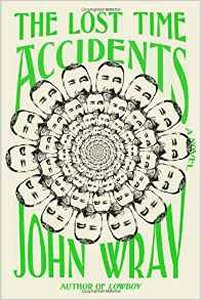Paul Di Filippo reviews John Wray
The Lost Time Accidents, by John Wray (Farrar, Straus & Giroux 978-0-374-28113-7, $27, 512pp, hardcover) February 2016
 One can seldom predict which sub-genres of SF will experience a resurgence in popularity at any given moment. Space opera, post-apocalypse, kaiju–they rise and fall in unforeseeable cycles, related somehow to the zeitgeist.
One can seldom predict which sub-genres of SF will experience a resurgence in popularity at any given moment. Space opera, post-apocalypse, kaiju–they rise and fall in unforeseeable cycles, related somehow to the zeitgeist.
At the moment, time travel seems big. Perhaps the most recent cycle started with Charles Yu in 2010, when his How to Live Safely in a Science Fictional Universe appeared. Predestination, the 2014 film version of Heinlein’s “ ‘—All You Zombies—’” is another landmark. The Lost Boys Symphony by Mark Andrew Ferguson from 2015 was a winner. And Wesley Chu’s new series starting with Time Salvager seems to be generating some buzz.
Now at hand to increment this tide of “chronic argonauts” is John Wray’s fourth novel, The Lost Time Accidents. I confess to not being familiar with Wray’s three previous novels, but the back cover blurbs invoking Murakami and Calvino immediately stoked my interest. And sure enough, right from the first page, we know where we are.
Wray’s book almost immediately reveals itself to be a very alluring, capable, and finely wrought instance of postmodern fantastika, in direct descent from Gaddis and Pynchon and Barth, through Helprin and Crowley (not to mention the afore-referenced Calvino and Murakami), and culminating at the moment with such youngsters as Reif Larsen, Matt Ruff and Nick Harkaway. Its prose is iridescent yet not overlabored; it blends gravitas with wry, even at times slapstick humor, serious metaphysics with irony, scholarship with pop culture; its ambition and range of materials is large, but eccentrically selective, essentially that of some obsessive monomaniac; it honors both history and the present moment; it transcribes existence accurately yet tinted through the filters of the writer. In short, it’s true art, not a mere product of the industrial-entertainment complex. Which is not to say it is not also vastly entertaining.
We initially encounter our hero, Waldemar Tolliver, dislocated from time, in a perpetual zone of eternity. Somewhat hazy on how he got there, he now seemingly is restricted to just a single room–the trash-stuffed study in an apartment once inhabited by his hoarder aunts at the edge of Harlem–at the precise eternal moment of 8:47 EST. Facing a ream of typing paper and a nice fountain pen provided by some mysterious patron, he sees no option other than to record his whole tangled life, extending back to a seminal discovery made by his great-grandfather, in hopes of discovering where he misstepped. To bolster his spirits, he imagines that his manuscript will be read by his ex-lover, one Mrs. Haven. And so, with this setup, which brings to mind Tom Disch’s famous story, “The Squirrel Cage,” off we go on a wild trip through time and space.
Waldemar’s family history really begins in the year 1903, in Central Europe, where his great-grandfather Ottokar, a pickle-maker by trade but amateur scientist by calling, makes an important discovery about the true nature of time. This discovery will blight the lives of the next three generations. Unfortunately, Ottokar dies before being able to disclose this revelation to his two sons, Kaspar and Waldemar. The former more or less forgets the quest, but the latter, eventual grand-uncle and namesake to our hero, eventual Nazi death camp commandant, becomes fixated on the matter.
As a college student in Vienna, Waldemar the First thinks he relearns the mystery: “Time travels in circles. Not in lines, but in circles–in spheres, to be more precise…We are trapped within them [the chronospheres], stuck to the inner skin, like dust grains in the surface of a bubble.” Shortly after this epiphany, Waldemar vanishes, leaving brother Kaspar to marry the louche and bohemian Sonja and to build his own career. Kaspar will emigrate to the USA in 1939, fathering two daughters and a son, Orson Card Tolliver. Orson becomes Waldemar the Second’s father.
All of this older history, up to the emigration, is delivered in a near-steampunk atmosphere, rich with the colors and sensual delights of that era. The sections in the USA, from 1939 right up to Waldemar the Second’s present-day, all partake of the detailed ambiance of their respective periods, from WWII patriotism to Eisenhowerian conformity to Sixties counterculture, and onward. Wray shows a deft hand at world-building the past.
And at intervals our narrative keeps returning to Waldemar the Second’s humiliating and perplexing imprisonment in his “singularity,” and his recollections of how he wooed Mrs. Haven, wife of an amoral millionaire. These passages have the quality of a J. P. Donleavy farce. Until we learn that the cruel and amoral Mr. Haven is part of a mysterious organization that wants the Tolliver family secrets and will stop at nothing to get it.
This particular plot angle necessitates me explaining one of the neatest aspects of this book. Orson Card Tolliver is an SF writer, a combination of Vonnegut’s Kilgore Trout and Steve Aylett’s Jeff Lint. (And in fact the whole riff about Waldemar the First experiencing random oscillating time jumps—he eventually shows up inside his namesake’s singularity apartment—is an obvious homage to Slaughterhouse-Five.) Wray has immense fun with this business, and exhibits intimate knowledge of our field (even if he does misspell “Budrys” as “Burdrys.”) His titles and plot outlines and sample passages for Orson Card Tolliver’s opuses are laugh-out-loud funny. Wray’s portrait of Orson Card Tolliver instantly ascends to the same pulp Olympus where Trout and Lint reside.
Orson Card, like all the Tollivers, including his two hoarder sisters, is plagued by Ottakar’s “Lost Time Accidents” and he inserts many of his speculations into his fictions. These eventually lead to the founding, L. Ron Hubbard-style, of the “U. S. Church of Synchronology,” whose members dress in corduroy because the texture of the fabric resembles parallel timestreams of the multiverse. It is this cult to which Mr. Haven belongs.
With all these pieces—and some others—intricately assembled, Wray maneuvers poor Waldemar the Second through layers of conspiracy and metaphysics, climaxing in a kind of van Vogtian fugue.
For a book concerned with time travel, The Lost Time Accidents is resolutely linear. Wray really has no use for the clichés of paradoxes and jumbled continuity. Instead he is intent on chronicling with grim humor the weight of eternity and mortality that afflicts all of us. In the case of the time-tormented Tollivers, they are the quivering canaries in the temporal coal mine of the cosmos. And that’s a description worthy of Orson Card Tolliver himself!




